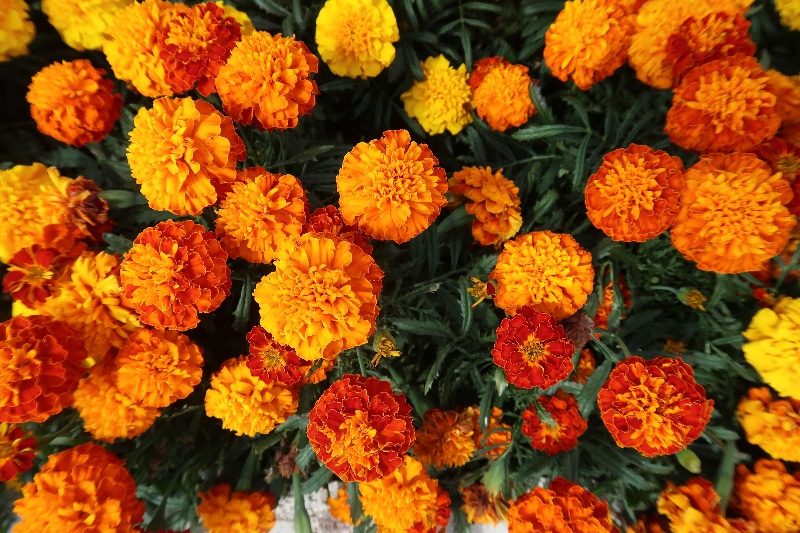Want to know how to harvest marigold flowers and seeds? Marigold flowers are a mainstay in most of the gardens. They bloom beautiful flowers all season long and they’re easy to grow from seed. Knowing how to save marigold seeds is essential if you want to continue growing them the next season.
Fortunately, harvesting marigold seeds are quite quick and easy. You only need to take the seeds from the flowers and let them air dry before storing them during the winter season. You can pack it up with a container or seed packets to save even more for the next growing season. Some of the marigold flowers are edible and best to mix in your salads to add a distinct flavor to it.

Tools You’ll Need to Harvest Marigold Flowers
The tools you’ll need to harvest marigold flowers include a basket or other available containers that can be used in harvesting flowers. You’ll also need some paper towels, a sharp knife, a pair of scissors, or gardening shears.
Since you need to evaluate or describe the process, get yourself some notes. Seed packets can be envelopes or closed-air containers excluding plastic containers and bags.
How to Harvest Marigold Flowers and Seeds
Here’s how you can harvest marigold plants for flower arrangements and bouquets:
Letting Marigold Flowers Dry
It’s important to wait until the right time to collect marigold seeds. You can harvest the seeds when the petals are dry already (when the base of each flower turning brownish). However, make sure there’s still is a bit of green color left in the base of the bloom. If you also wait until it is completely turned brown, it may start to rot or mold. It’s important to wait for the perfect time to harvest marigolds since the timing is crucial to have the right quality of marigold seeds.
Tip in harvesting: While you are harvesting, simply cut each marigold flower heads using your cutting equipment or either pinch it with your finger. However, be sure not to pull the flowers as it can harm the roots of your marigolds.
Opening the Marigold
Get your paper towel and set it on a flat surface. After, hold each bloom’s base, pull-off, and discard the petals and leaves of it. Then, you will easily notice the attached seeds inside the base. In the meantime, set the prepared blooms on your paper towels for bulk removal of seeds. You may also use larger towels to manage and accommodate the abundant blooms of your marigolds.
Removal of Marigold Seeds
Marigold seeds are likely to have a long, slender, and pointed appearance. Divided ends with black color and white color on the opposite edge. Gather your blooms, pull-off all petals, and leaves, and start pulling the seeds from the base. After getting all marigold seeds, discard the base in a single place like in bins or garbage bags. After sorting, put another paper towel on another flat surface and spread the pulled marigold seeds on it.
Drying of Seeds
As mentioned above, let your marigold seeds air dry for about a week in an uncovered paper towel. It will enable them to be preserved even in frost season and will prevent it from getting rot and mold.
Seed Storing
After drying the seeds, gather them and start placing them inside your seed packets to prolong their lifespan and will still be used after the frost date. Do not use plastic bags in storing your marigold seeds because it will retain residual moisture, which will affect your marigold seeds and even get rot and mold. To avoid forgetting about your marigold seeds, put a label on it to prevent possible disposal if unlabeled.
Using Stored Seeds for Replanting
After storing your collected marigold seeds, it is perfect to plant during the growing season. You can enjoy once again the benefits of it from house beautification to an edible ingredient for your salad.
Facts about Marigold Flowers
Marigolds are especially good for repelling insects and pests, making them companion plant for tomatoes, eggplants, tomatoes, and chili pepper because of its pungent scent of some variety. It is amazing having this kind of flow in your plant, imagine you don’t only have a beautiful attractive garden but having also a very natural insect and pest repellent that will protect your plants from any abrogation.
African marigolds have larger flower heads on plants that grow from 10 to 36 inches tall. While French marigolds are smaller and bushier, having only two inches of flower head across on plants and only having six to eighteen inches height. Sizes and colors vary on its classification, having a mixed combination is pretty great, will also add more pleasant and abundant color to your garden.
The Benefits of Growing Marigolds in a Greenhouse
Have you ever thought of growing your marigolds in a greenhouse? If you haven’t, it’s time to consider getting a greenhouse.
Greenhouses are great for keeping your marigolds safe from pests and diseases. Marigolds are susceptible to insects and blight, such as caterpillars, aphids, leaf spots, and mildews. You can lower the risk of plant damage by growing your marigolds in a greenhouse.
Additionally, greenhouses can also keep your plants safe from bad weather that could easily damage your flowers.
Final Thoughts on How to Harvest Marigold Flowers and Seeds
Knowing how to harvest marigold flowers and seeds is crucial if you’re planning to plant them in your garden. These beautiful flowers that usually come in yellow and orange colors are a great addition to any garden or flower arrangement.
